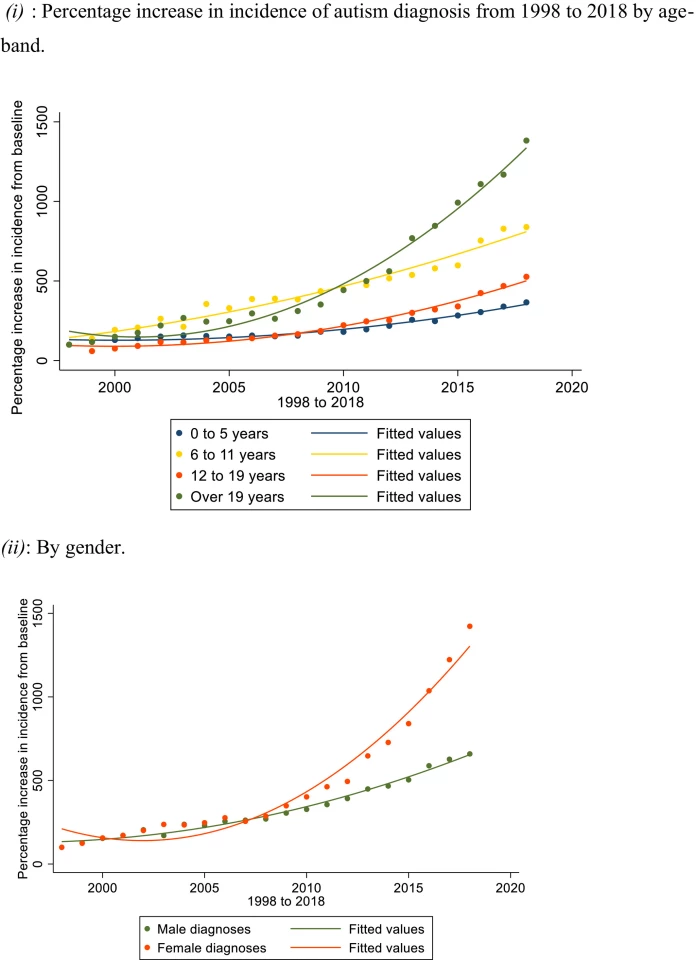Research tracking rates of autism over the past 20 years in England has found a striking increase in the volume of diagnoses. The study shows autism diagnoses rose by 787 percent over two decades, however, the growth is most likely due to increased reporting and greater detection of the condition in adults.
Published in the Journal of Child Psychology and Psychiatry, the new study analyzed health records from nine million people in England, spanning a period from 1998 to 2018. Across that period overall diagnoses of autism rose by 787 percent, however, the study offers much more insight than simply pointing out this general increase.
The main strength and novelty of this study is its breakdown of the data by gender and developmental stage. While the researchers detected increases in autism diagnoses across each age group over the 20-year period, by far the biggest increase came in adult diagnoses over the age of 19.
Ginny Russell, lead author on the new study from the University of Exeter, says the major spikes in recent autism diagnoses were primarily seen in females and older people. And this indicates the massive overall growth in numbers is more likely due to increased identification in certain demographics and not a "real" increase in people with neurodevelopmental problems.
“The definition of what constitutes autism has changed over time, and females and adults were not often thought of as having autism 20 years ago,” says Russell. “The vocal work of charities and media coverage, combined with changes in policy has led to more assessment centres for adults, and an autism narrative that many women and girls identify with. Consequently demand for diagnosis has never been higher.”

The study does note that the possibility of real increases in the number of individuals having symptoms of autism cannot be discounted, even though the researchers are confident the growth seems to be an artifact of greater clinical recognition. James Cusack, from UK autism research charity Autistica, agrees with that interpretation saying women historically have been less likely to be diagnosed with autism so it is positive that this demographic group is increasingly recognized.
“The most likely explanation for this increase in diagnoses is broader diagnostic criteria and better awareness and understanding of autism,” says Cusack, who did not work on this new study. “There is no compelling evidence to suggest that we are seeing a 'real' increase in the number of autistic people at the moment or that there is anything that could be driving that increase.”
Uta Frith, from University College London, is a little more circumspect about the new findings. She sees the new study as important but warns the broadening of autism’s diagnostic criteria threatens the usefulness of the diagnosis in the first place.
“It strongly suggests that the diagnosis of autism has been stretched to breaking point and has outgrown its purpose,” says Frith. “If the purpose is to predict what an individual’s needs are, this is no longer possible. Researchers need to think hard about how to disentangle the underlying conditions in individuals now all labelled autistic.”
Frith’s point touches on growing concerns regarding potential over-diagnoses of autism. While recent broadening of the boundaries of autism undeniably helps some obtain treatment when they previously didn’t fit into specific diagnostic boxes, it can also promote, among other things, incorrect perceptions about increasing prevalence. This can lead to false information spreading, such as false links between childhood vaccinations and autism.
Tim Nicholls, from the National Autistic Society, is much more positive about the current diagnostic rates. He says improvements in professional understanding and more accurate representations in film and television help the neurodiverse feel more accepted.
“Autistic people routinely report feeling misunderstood, struggling without the right support or feeling judged and mocked,” says Nicholls. “A diagnosis can be life changing and is vital to getting the right care and support.”
The new study was published in the Journal of Child Psychology and Psychiatry.
Source: University of Exeter





